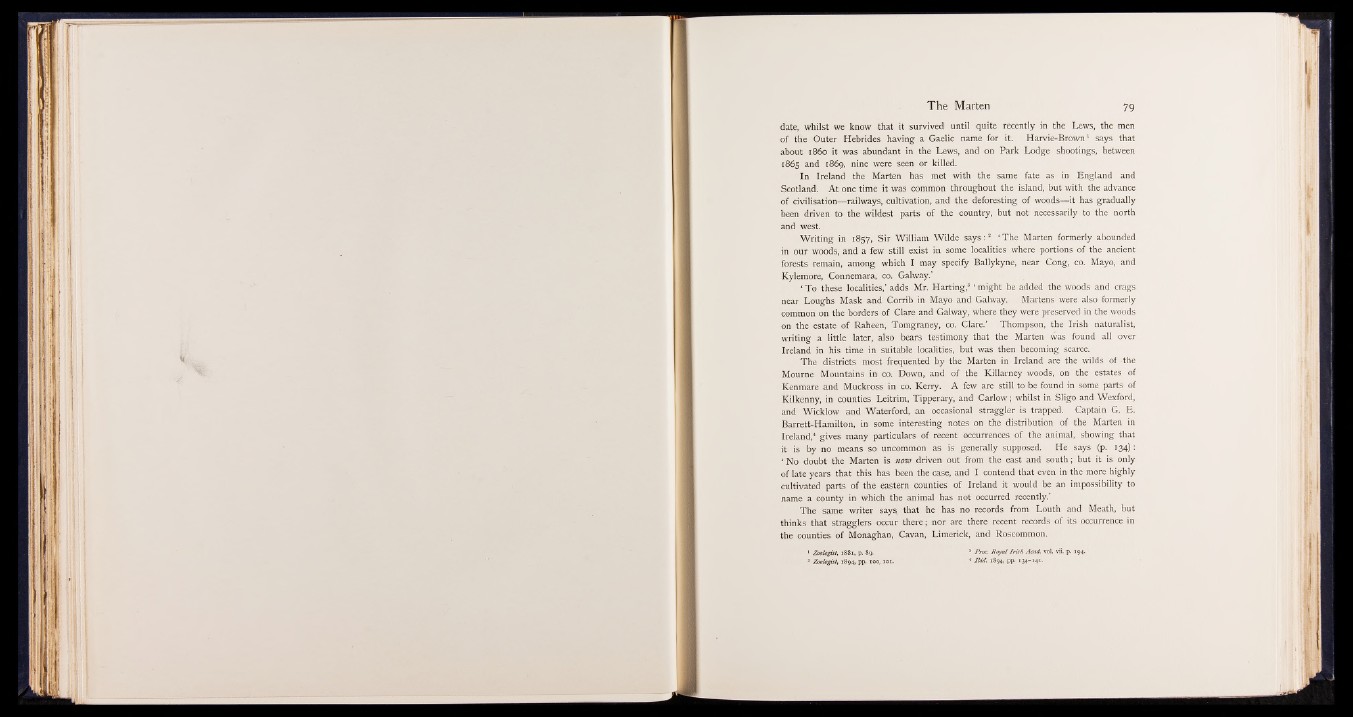
date, whilst we know that it survived until quite recently in the Lews, the men
of the Outer Hebrides having a Gaelic name for it. Harvie-Brown1 says that
about i860 it was abundant in the Lews, and on Park Lodge shootings, between
1865 and 1869, nine were seen or killed.
In Ireland the Marten has met with the same fate as in England and
Scotland. At one time it was common throughout the island, but with the advance
of civilisation—railways, cultivation, and the deforesting of woods—it has gradually
been driven to the wildest parts of the country, but not necessarily to the north
and west.
Writing in 1857, S ir William Wilde s ay s : 2 ‘ The Marten formerly abounded
in our woods, and a few still exist in some localities where portions of the ancient
forests remain, among which I may specify Ballykyne, near Cong, co. Mayo, and
Kylemore, Connemara, co. Galway.’
‘ To these localities,’ adds Mr. Harting,8 ‘ might be added the woods and crags
near Loughs Mask and Corrib in Mayo and Galway. Martens were also formerly
common on the borders of Clare and Galway, where they were preserved in the woods
on the estate of Raheen, Tomgraney, co. Clare.’ Thompson, the Irish naturalist,
writing a little later, also bears testimony that the Marten was found all over
Ireland in his time in suitable localities, but was then becoming scarce.
The districts most frequented by the Marten in Ireland are the wilds of the
Mourne Mountains in co. Down, and of the Killarney woods, on the estates of
Kenmare and Muckross in co. Kerry. A few are still to be found in some parts of
Kilkenny, in counties Leitrim, Tipperary, and Carlow; whilst in Sligo and Wexford,
and Wicklow and Waterford, an occasional straggler is trapped. Captain G. E.
Barrett-Hamilton, in some interesting notes on the distribution of the Marten in
Ireland,4 gives many particulars of recent occurrences of the animal, showing that
it is by no means so uncommon as is generally supposed. He says (p. 134):
‘ No doubt the Marten is now driven out from the east and south; but it is only
of late years that this has been the case, and I contend that even in the more highly
cultivated parts of the eastern counties of Ireland it would be an impossibility to
name a county in which the animal has not occurred recently.’
The same writer say$ that he has no records from Louth and Meath, but
thinks that stragglers occur there; nor are there recent records of its occurrence in
the counties of Monaghan, Cavan, Limerick, and Roscommon.
1 Zoologist, 1881, p. 89.
3 Zoologist1894, pp. 10
2 Proc. Poyal Irish Acad. vol. vii. p. 194.
4 Ibid. 1894, pp. 134-141-